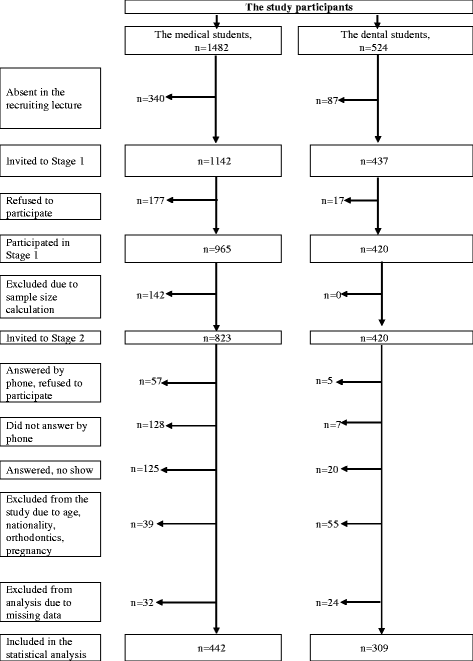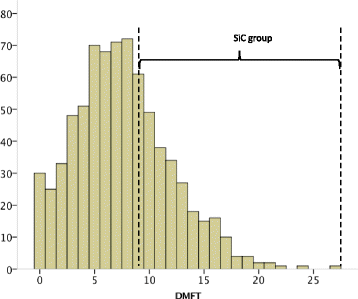Dental caries experience and determinants in young adults of the Northern State Medical University, Arkhangelsk, North-West Russia: a cross-sectional study
- PMID: 29183304
- PMCID: PMC5706395
- DOI: 10.1186/s12903-017-0426-x
Dental caries experience and determinants in young adults of the Northern State Medical University, Arkhangelsk, North-West Russia: a cross-sectional study
Abstract
Background: Little information exists about the experience of and risk factors for dental caries in young adults in Russia. We investigated dental caries experience and determinants in medical and dental students in North-West Russia.
Methods: This cross-sectional study included 442 medical and 309 dental undergraduate students of Russian nationality aged 18-25 years from the Northern State Medical University, Arkhangelsk, Russia. Information on socio-demographic factors and oral health behaviour (regularity of dental visits, frequency of tooth-brushing, using toothpaste with fluoride, and skipping tooth-brushing) was obtained from a structured, self-administered questionnaire. Dental caries experience was based on the decayed (D) missing (M) filled (F) teeth (T) index and the Significant Caries (SiC) index, which were assessed through dental examination. Students with a DMFT index ≥9 were placed in the SiC group. Negative binomial hurdle and multivariable binary logistic regressions were used for statistical analyses.
Results: The prevalence of dental caries (DMFT >0) was 96.0%, overall mean DMFT index was 7.58 (DT: 0.61, MT: 0.12, and FT: 6.84), and the corresponding SiC index was 12.50. Age 21-25 years (incidence rate ratio [IRR] = 1.09, 95% confidence interval [CI]: 1.01-1.18), being a female (IRR = 1.10, 95% CI: 1.01-1.20), high subjective socioeconomic status (SES) [IRR = 1.11, 95% CI: 1.02-1.21], and skipping tooth-brushing (IRR = 1.09, 95% CI: 1.00-1.19) were associated with a higher DMFT index. DMFT index also increased among students who reported regular dental visits (IRR = 1.22, 95% CI: 1.10-1.36), but their odds of being in the dental caries-free group decreased (odds ratio [OR] = 0.38, 95% CI: 0.18-0.82). Significant predictors of being categorised to the SiC group were older age (OR = 1.41, 95% CI: 1.03-1.92), high subjective SES (OR = 1.57, 95% CI: 1.13-2.19), and regular dental visits (OR = 2.34, 95% CI: 1.56-3.51).
Conclusions: A high prevalence of dental caries and high DMFT index, with a dominance of FT, were observed in our Russian medical and dental students. Age, sex, subjective SES, regular dental visits, and skipping tooth-brushing were determinants of dental caries experience.
Keywords: DMFT; Medical and dental students; North-West Russia; Young adults.
Conflict of interest statement
Ethics approval and consent to participate
The study was approved by the Regional Ethical Committee of Norway (2015/1788/REK nord) and the Ethical Committee of the NSMU, Russia (№ 05/10–15 from 19.10.2015). Verbal and written informed consent was obtained from every participant at Stage 1. For those willing and interested to participate in the study, the main researcher also gave assurance of confidentiality of the obtained information and stressed that the participant could withdraw from the study at any time.
Consent for publication
Not applicable.
Competing interests
The authors declare that they have no competing interests.
Publisher’s Note
Springer Nature remains neutral with regard to jurisdictional claims in published maps and institutional affiliations.
Figures
Similar articles
-
Prevalence of and factors associated with dental anxiety among medical and dental students of the Northern State Medical University, Arkhangelsk, North-West Russia.Int J Circumpolar Health. 2018 Dec;77(1):1454786. doi: 10.1080/22423982.2018.1454786. Int J Circumpolar Health. 2018. PMID: 29564967 Free PMC article.
-
Oral Health-Related Quality of Life in Young Adults: A Survey of Russian Undergraduate Students.Int J Environ Res Public Health. 2018 Apr 11;15(4):719. doi: 10.3390/ijerph15040719. Int J Environ Res Public Health. 2018. PMID: 29641464 Free PMC article.
-
Perceived Stress and Associated Factors in Russian Medical and Dental Students: A Cross-Sectional Study in North-West Russia.Int J Environ Res Public Health. 2020 Jul 27;17(15):5390. doi: 10.3390/ijerph17155390. Int J Environ Res Public Health. 2020. PMID: 32727038 Free PMC article.
-
Determinants of dental caries in children in the Middle East and North Africa region: a systematic review based on literature published from 2000 to 2019.BMC Oral Health. 2021 May 4;21(1):237. doi: 10.1186/s12903-021-01482-7. BMC Oral Health. 2021. PMID: 33947387 Free PMC article.
-
Trends in dental caries of deciduous teeth in Iran: a systematic analysis of the national and sub-national data from 1990 to 2017.BMC Oral Health. 2022 Dec 23;22(1):634. doi: 10.1186/s12903-022-02634-z. BMC Oral Health. 2022. PMID: 36564764 Free PMC article.
Cited by
-
The Impact of Lifestyles on Dental Caries of Adult Patients in Udupi District: A Cross-Sectional Study.J Int Soc Prev Community Dent. 2020 Mar 5;10(2):189-195. doi: 10.4103/jispcd.JISPCD_293_19. eCollection 2020 Mar-Apr. J Int Soc Prev Community Dent. 2020. PMID: 32670908 Free PMC article.
-
Oral Behavior and Dental Status of Orthodox Christian Priests and Monks.J Int Soc Prev Community Dent. 2019 Mar-Apr;9(2):137-143. doi: 10.4103/jispcd.JISPCD_326_18. Epub 2019 Apr 12. J Int Soc Prev Community Dent. 2019. PMID: 31058063 Free PMC article.
-
Caries prevalence among 18 years old, an epidemiological survey in Israel.Isr J Health Policy Res. 2020 Aug 31;9(1):45. doi: 10.1186/s13584-020-00402-4. Isr J Health Policy Res. 2020. PMID: 32867853 Free PMC article.
-
Examining Myeloperoxidase (MPO) biomarker in the saliva of patients with Lactobacillus-associated caries in Hilla City.J Med Life. 2023 Jul;16(7):1093-1097. doi: 10.25122/jml-2021-0138. J Med Life. 2023. PMID: 37900082 Free PMC article.
-
The potential impact of age, gender, body mass index, socioeconomic status and dietary habits on the prevalence of dental caries among Egyptian adults: a cross-sectional study.F1000Res. 2019 Mar 1;8:243. doi: 10.12688/f1000research.17892.1. eCollection 2019. F1000Res. 2019. PMID: 30906540 Free PMC article.
References
-
- da Silveira Moreira R. Epidemiology of dental caries in the world. In: Virdi PM, editor. Oral health care - pediatric, research, epidemiology and clinical practices. Rijeka: InTech; 2012. pp. 149–168.
-
- Koposova N, Eriksen HM, Widstrom E, Handegard BH, Pastbin M, Koposov R. Caries prevalence and determinants among 12-year-olds in north-West Russia and northern Norway. Stomatologija. 2013;15:3–11. - PubMed
-
- Kojima A, Ekuni D, Mizutani S, Furuta M, Irie K, Azuma T, et al. Relationships between self-rated oral health, subjective symptoms, oral health behavior and clinical conditions in Japanese university students: a cross-sectional survey at Okayama University. BMC Oral Health. 2013;13:62. doi: 10.1186/1472-6831-13-62. - DOI - PMC - PubMed
MeSH terms
Grants and funding
LinkOut - more resources
Full Text Sources
Other Literature Sources
Medical



